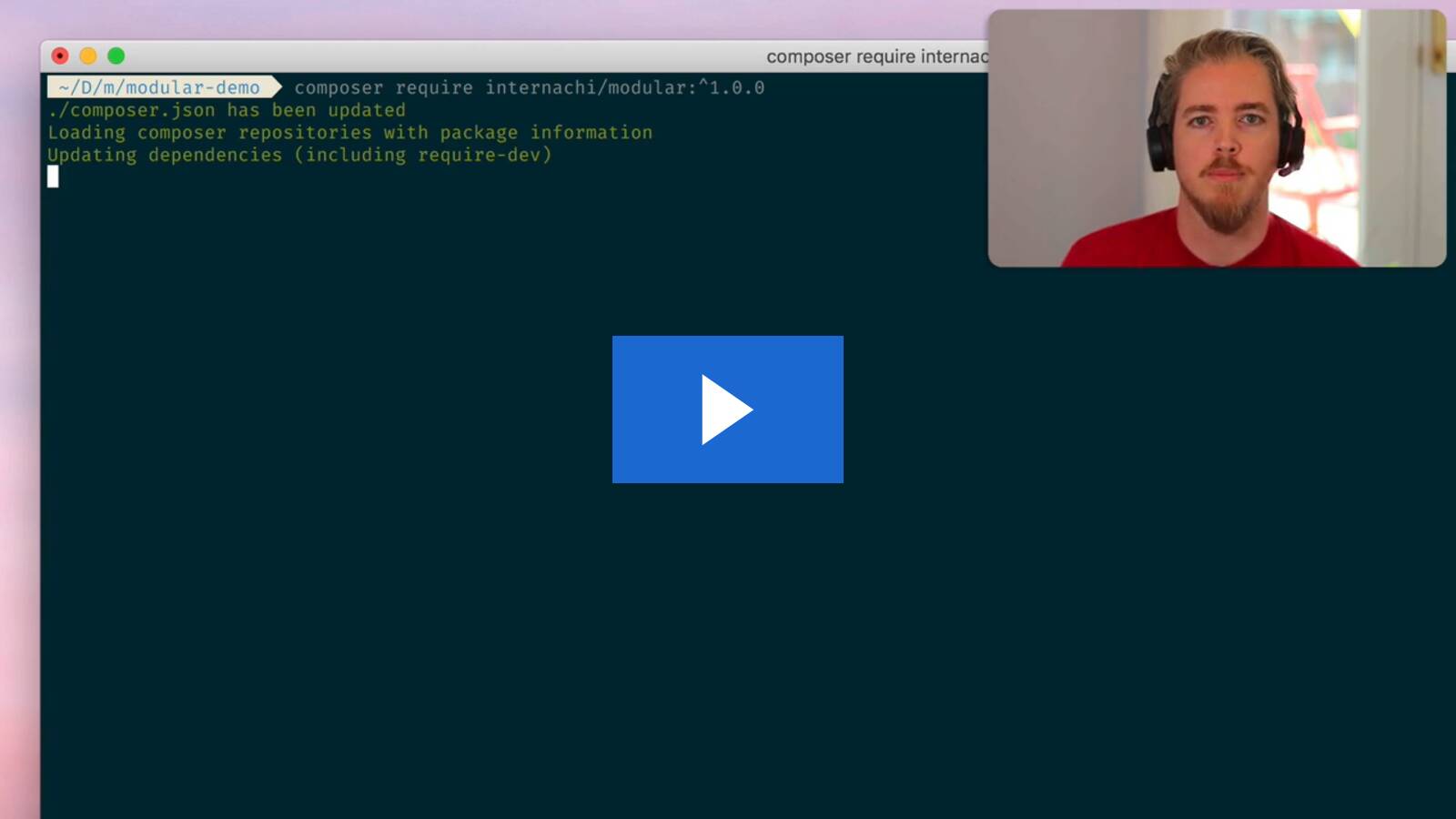internachi/modular is a module system for Laravel applications. It uses
Composer path repositories for autoloading,
and Laravel package discovery for module
initialization, and then provides minimal tooling to fill in any gaps.
This project is as much a set of conventions as it is a package. The fundamental idea
is that you can create “modules” in a separate app-modules/ directory, which allows you to
better organize large projects. These modules use the existing
Laravel package system, and follow existing Laravel
conventions.
To get started, run:
composer require internachi/modularLaravel will auto-discover the package and everything will be automatically set up for you.
While not required, it's highly recommended that you customize your default namespace
for modules. By default, this is set to Modules\, which works just fine but makes it
harder to extract your module to a separate package should you ever choose to.
We recommend configuring a organization namespace (we use "InterNACHI", for example).
To do this, you'll need to publish the package config:
php artisan vendor:publish --tag=modular-configNext, let's create a module:
php artisan make:module my-moduleModular will scaffold up a new module for you:
app-modules/
my-module/
composer.json
src/
tests/
routes/
resources/
database/
It will also add two new entries to your app's composer.json file. The first entry registers
./app-modules/my-module/ as a path repository,
and the second requires modules/my-module:* (like any other Composer dependency).
Modular will then remind you to perform a Composer update, so let's do that now:
composer update modules/my-moduleYou can run the sync command to make sure that your project is set up for module support:
php artisan modules:syncThis will add a Modules test suite to your phpunit.xml file (if one exists)
and update your PhpStorm Laravel plugin
configuration (if it exists) to properly find your module's views.
It is safe to run this command at any time, as it will only add missing configurations.
You may even want to add it to your post-autoload-dump scripts in your application's
composer.json file.
All modules follow existing Laravel conventions, and auto-discovery should work as expected in most cases:
- Commands are auto-registered with Artisan
- Migrations will be run by the Migrator
- Factories are auto-loaded for
factory() - Policies are auto-discovered for your Models
- Blade components will be auto-discovered
- Event listeners will be auto-discovered
We provide a few helper commands:
php artisan make:module— scaffold a new modulephp artisan modules:cache— cache the loaded modules for slightly faster auto-discoveryphp artisan modules:clear— clear the module cachephp artisan modules:sync— update project configs (likephpunit.xml) with module settingsphp artisan modules:list— list all modules
We also add a --module= option to most Laravel make: commands so that you can
use all the existing tooling that you know. The commands themselves are exactly the
same, which means you can use your custom stubs
and everything else Laravel provides:
php artisan make:cast MyModuleCast --module=[module name]php artisan make:controller MyModuleController --module=[module name]php artisan make:command MyModuleCommand --module=[module name]php artisan make:component MyModuleComponent --module=[module name]php artisan make:channel MyModuleChannel --module=[module name]php artisan make:event MyModuleEvent --module=[module name]php artisan make:exception MyModuleException --module=[module name]php artisan make:factory MyModuleFactory --module=[module name]php artisan make:job MyModuleJob --module=[module name]php artisan make:listener MyModuleListener --module=[module name]php artisan make:mail MyModuleMail --module=[module name]php artisan make:middleware MyModuleMiddleware --module=[module name]php artisan make:model MyModule --module=[module name]php artisan make:notification MyModuleNotification --module=[module name]php artisan make:observer MyModuleObserver --module=[module name]php artisan make:policy MyModulePolicy --module=[module name]php artisan make:provider MyModuleProvider --module=[module name]php artisan make:request MyModuleRequest --module=[module name]php artisan make:resource MyModule --module=[module name]php artisan make:rule MyModuleRule --module=[module name]php artisan make:seeder MyModuleSeeder --module=[module name]php artisan make:test MyModuleTest --module=[module name]
In addition to adding a --module option to most make: commands, we’ve also added the same
option to the db:seed command. If you pass the --module option to db:seed, it will look
for your seeder within your module namespace:
php artisan db:seed --module=[module name]will try to callModules\MyModule\Database\Seeders\DatabaseSeederphp artisan db:seed --class=MySeeder --module=[module name]will try to callModules\MyModule\Database\Seeders\MySeeder
We can also add the --module option to commands in 3rd-party packages. The first package
that we support is Livewire. If you have Livewire installed, you can run:
php artisan make:livewire counter --module=[module name]
Your Laravel Blade components will be automatically registered for you under a component namespace. A few examples:
| File | Component |
|---|---|
app-modules/demo/src/View/Components/Basic.php |
<x-demo::basic /> |
app-modules/demo/src/View/Components/Nested/One.php |
<x-demo::nested.one /> |
app-modules/demo/src/View/Components/Nested/Two.php |
<x-demo::nested.two /> |
app-modules/demo/resources/components/anonymous.blade.php |
<x-demo::anonymous /> |
app-modules/demo/resources/components/anonymous/index.blade.php |
<x-demo::anonymous /> |
app-modules/demo/resources/components/anonymous/nested.blade.php |
<x-demo::anonymous.nested /> |
When you call make:module, Modular will scaffold some basic boilerplate for you. If you
would like to customize this behavior, you can do so by publishing the app-modules.php
config file and adding your own stubs.
Both filenames and file contents support a number of placeholders. These include:
StubBasePathStubModuleNamespaceStubComposerNamespaceStubModuleNameSingularStubModuleNamePluralStubModuleNameStubClassNamePrefixStubComposerNameStubMigrationPrefixStubFullyQualifiedTestCaseBaseStubTestCaseBase
Laravel Modules is a great package that’s been
around since 2016 and is used by 1000's of projects. The main reason we decided to build
our own module system rather than using laravel-modules comes down to two decisions:
- We wanted something that followed Laravel conventions rather than using its own directory structure/etc.
- We wanted something that felt “lighter weight”
If you are building a CMS that needs to support 3rd-party modules that can be dynamically enabled and disabled, Laravel Modules will be a better fit.
On the other hand, if you're mostly interested in modules for organization, and want to stick closely to Laravel conventions, we’d highly recommend giving InterNACHI/Modular a try!



